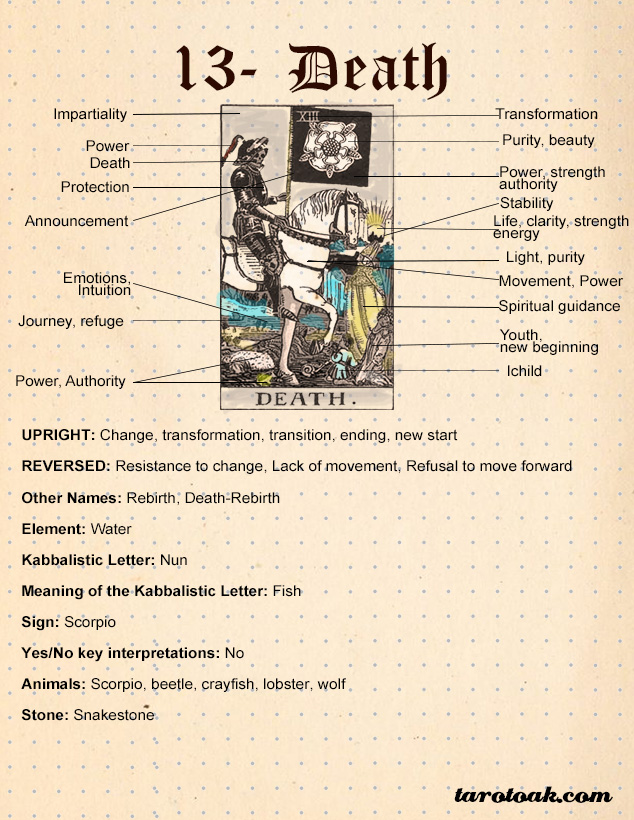The Death card in tarot, often met with trepidation and misunderstanding, stands as a profound metaphor for transition and transformation. Contrary to its ominous title, this card does not portend physical demise; rather, it embodies the cyclical nature of existence. The intricate symbolism woven into the fabric of the Death card reveals layers of meaning, hinting at the death of one phase and the birth of another. This duality mirrors life itself, where endings invariably pave the way for new beginnings.
Understanding the Symbolism
The imagery of the Death card typically portrays a skeletal figure clad in armor, astride a pale steed. This somber representation serves as a reminder that change is an inevitable aspect of the human experience. The horse, often white, symbolizes purity and the journey toward a renewal. Around them, fallen bodies may be depicted, signifying the release of the past and the shedding of outdated identities or situations. Flowers sometimes accompany these images, symbolizing the beauty of rebirth that follows the process of letting go.
Additionally, the card may feature elements such as the sun and the horizon, illustrating hope and the promise of dawn after a long night. The juxtaposition of these symbols within the card provides a rich tapestry for interpretation, unearthing concerns regarding permanence and the acceptance of the transient nature of life.
Common Observations
Many individuals express an instinctual fear when encountering the Death card in a reading. This apprehension often stems from cultural conditioning, immersing us in a narrative that associates death strictly with loss. Society tends to equate death with finality, fostering a reluctance to confront the concept of change. Yet, the card’s presence often signals an urgent need for self-reflection and transformation. The very act of drawing this card can illuminate stagnation within one’s life, prompting an exploration of what must be relinquished in order to foster growth.
Moreover, the allure of the Death card lies in its capacity to serve as both a harbinger of unsettling truths and a catalyst for profound liberation. When faced with immovable circumstances or emotionally fraught connections, the Death card beckons us to disentangle from those bonds. It nudges the querent toward the stark realization that to evolve, one must embrace the notion of letting go. In this very act, death transcends its superficial implication, evolving into a metaphor for personal development.
Transition and Renewal
Central to the Death card’s meaning is its association with transition and renewal. It resonates with the idea of metamorphosis, akin to the transformative journey of a caterpillar emerging as a butterfly. Such transformations require a relinquishment of former selves, signifying that only through embracing change can individuals unveil their fullest potential. This card’s acquisition in a reading often heralds a phase of personal reinvention, wherein newfound opportunities and a more authentic existence await.
The process of transformation can shatter illusions and dismantle old paradigms, inviting introspection and a reconceptualization of beliefs. Each cycle of life harbors the seeds of personal evolution; thus, the embrace of change becomes fundamental for anyone seeking authenticity. The Death card compels individuals to traverse the unknown, urging them to surrender comfort zones that have long ceased to serve their best interests.
Practical Lessons from the Death Card
Engaging with the energies of the Death card teaches valuable lessons in emotional resilience and adaptability. It encourages individuals to confront fears directly, acknowledging that the dread of loss often overshadows the beauty of what lies ahead. By reframing loss as a catalyst for opportunity, one can cultivate an empowering perspective that nurtures growth and fosters exploration. This shift in mindset underscores the acceptance of life’s impermanence, prompting individuals to cherish the present instead of merely clinging to the past.
Furthermore, the Death card emphasizes the importance of authentic connections and relationships. Ties that have become toxic or detrimental may require severance, encouraging individuals to prioritize their well-being. This card serves as a reminder that one must engage in relationships that foster mutual growth and respect, shedding those that inhibit personal progress. The act of letting go, though daunting, is ultimately liberating, creating space for healthier and more fulfilling connections.
Conclusion: Embracing the Death Card
The Death card embodies a multitude of meanings that extend well beyond the confines of conventional interpretations. It acts as a profound harbinger of transformation—encouraging introspection and the courage to release stagnation in favor of growth. Rather than fear, the presence of this card should inspire a reverence for life’s exquisite cycles and an appreciation for the possibility that every ending unfurls into a different beginning. Ultimately, embracing the wisdom of the Death card allows individuals to live authentically, navigating their journeys with a spirit of resilience, openness, and hope for the future.









Leave a Comment